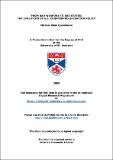Files in this item
From bad weapons to bad states: the evolution of U.S. counterproliferation policy
Item metadata
| dc.contributor.advisor | Lang, Anthony F. | |
| dc.contributor.author | Quaintance, Michael Kimo | |
| dc.coverage.spatial | 323 | en_US |
| dc.date.accessioned | 2009-11-30T16:05:14Z | |
| dc.date.available | 2009-11-30T16:05:14Z | |
| dc.date.issued | 2009-11-30 | |
| dc.identifier.uri | https://hdl.handle.net/10023/820 | |
| dc.description.abstract | One of the key features of the 2002 United States National Security Strategy was an abrupt shift from the traditional U.S. approach to proliferation threats that prioritized deterrence and promotion of nondiscriminatory nonproliferation norms, to an approach called counterproliferation that emphasized military preemption and direct challenges to adversarial state identity. This thesis asks the question, what caused counterproliferation to largely replace deterrence and nonproliferation as the central national security policies of the U.S. concerning unconventional weapons? The thesis argues that to understand this policy change requires not merely an appreciation of changes in the post-Cold War international security environment, but also an examination of how culturally shaped threat conceptions among American policymakers interacted with capabilities development and policy institutionalization within the U.S. military. As no current theory adequately addresses those dynamics, complimentary strategic culture and organizational theory models are presented as the framework for analysis. This thesis will contend that policy shift from NP to CP resulted from the merging of strategic cultural efforts aimed at legitimizing conceptions of proliferation threats as originating from state identity, with a military organizational drive to avoid uncertainty through the development of counterproliferation capabilities. Together these strategic cultural and organizational responses to shifting proliferation threats altered the menu of choice for policymakers by institutionalizing and legitimizing a policy response that directly challenged existing nonproliferation norms and practices. This thesis relies on a detailed case study of the evolution of counterproliferation policy from 1993 to 2002, with particular focus on the analysis of public discourse, declassified policy planning and Department of Defense documents, and participant interviews. | en_US |
| dc.language.iso | en | en_US |
| dc.publisher | University of St Andrews | |
| dc.rights | Creative Commons Attribution-NonCommercial-NoDerivs 3.0 Unported | |
| dc.rights.uri | http://creativecommons.org/licenses/by-nc-nd/3.0/ | |
| dc.subject | Counterproliferation | en_US |
| dc.subject | Nonproliferation | en_US |
| dc.subject | U.S. National Security Strategy | en_US |
| dc.subject | Strategic culture | en_US |
| dc.subject | Organizational theory | en_US |
| dc.subject.lcc | UA23.Q25 | |
| dc.subject.lcsh | National security--United States | en |
| dc.subject.lcsh | Nuclear nonproliferation--Government policy--United States | en |
| dc.subject.lcsh | Arms control--Government policy--United States | en |
| dc.subject.lcsh | United States--Military policy--20th century | en |
| dc.title | From bad weapons to bad states: the evolution of U.S. counterproliferation policy | en_US |
| dc.type | Thesis | en_US |
| dc.accrualMethod | United States--Military policy--21st century | en |
| dc.accrualMethod | uk.bl.ethos.552303 | |
| dc.type.qualificationlevel | Doctoral | en_US |
| dc.type.qualificationname | PhD Doctor of Philosophy | en_US |
| dc.publisher.institution | The University of St Andrews | en_US |
This item appears in the following Collection(s)
Except where otherwise noted within the work, this item's licence for re-use is described as Creative Commons Attribution-NonCommercial-NoDerivs 3.0 Unported
Items in the St Andrews Research Repository are protected by copyright, with all rights reserved, unless otherwise indicated.


